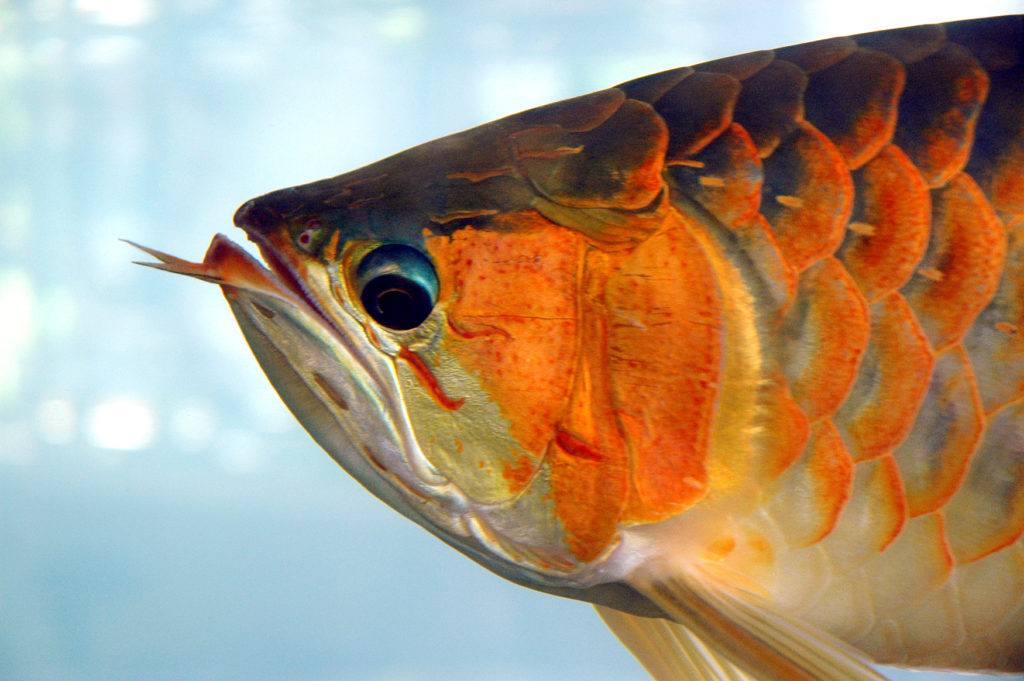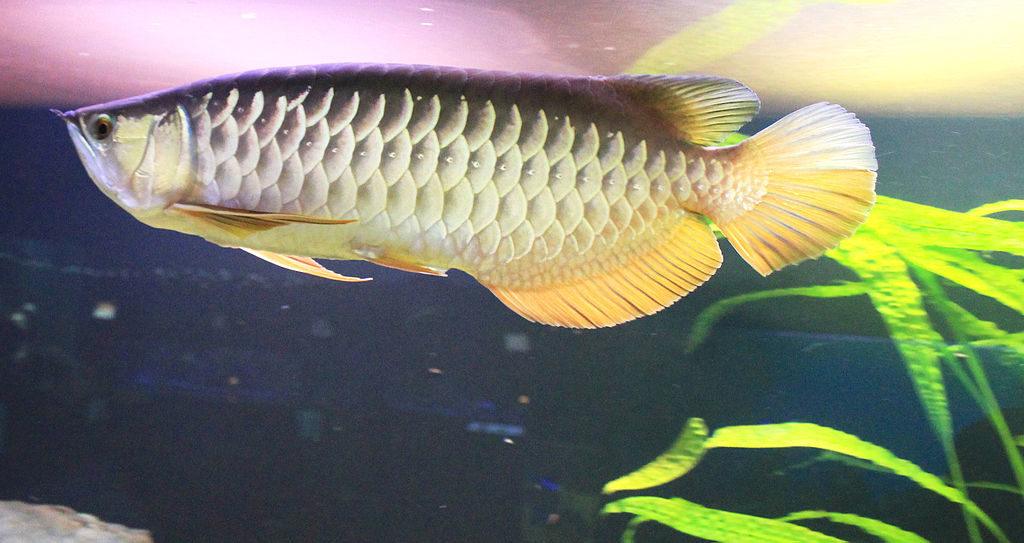The Arowana is a prehistoric-looking fish – long, sleek, and beautiful. Also called the Dragon fish, Bony Tongues, or Monkey fish, they are thought to bring good luck and fortune.
Featured in many Chinese mythologies and folklores due to their resemblance to the Chinese dragon, they are voracious predators.

While considered unique and challenging fish to keep, they can be very rewarding as well.
There are a few different varieties from different areas of the world, including the Silver Arowana, the Black Arowana, the Australian Arowana, the Red Arowana, and the African Arowana.
If you’re considering them as your new pet, then we have all the information you’ll need right here.
Contents
Arowana Types, Appearance and Personality
Basic Facts
The Arowana fish is a predatory fish, and the different varieties all have slightly different requirements.
They are an archaic-looking, bony fish that feeds from the surface, and are all powerful jumpers and aggressive eaters.
They have large, downturned mouths with barbels on the chin, and their eyes face towards the surface to hunt for prey. Their long tail and large scales vary in color based on the species.
Silver and Black
The Silver Arowana is a South American fish native to the Amazon River Basin, and is the most common of Arowanas available for your home tank.
They can grow up to four feet long, weigh about 10 pounds, and live 10-15 years in captivity. Most captive Arowanas don’t get larger than three feet, but they are powerful fish that can pack a hefty bite.
These Arowanas have the least restrictions and are the cheapest type available. The Arowana price is largely due to not only how specialized these fish are, but because of their associations with luck and wealth.
The Black Arowana is very similar to the Silver Arowana, but may be more expensive due to their sought-after color.
Asian, or Golden
Asian Arowanas (or Golden Arowanas) are the most highly prized of these types of fish, and also the most restricted.
They are an endangered species, so trading them is illegal unless they are over thirty years old or captive bred.
These fish are all marked with microchips to prove that they are legally bred and traded. They are also the most expensive of all of the Arowanas.
They originate in Southeast Asia in slow-moving waters, and this enchanting fish has a large place in Chinese mythology for their resemblance to Chinese dragons.
Australian
Australian Arowanas are believed to be the ancestors of all modern species of Arowana. They are also an endangered species and should be micro-chipped like the Asian variety.
They live in slow-moving waters and like water that is soft and acidic. It is thought they branched off from the other species because of their intolerance to salt water.
Red
The Red Arowana is an expensive and sought-after variety of Arowana who, despite the name, can vary in color from red, purple, green, yellow, and orange, but are usually very high-contrast and vibrant.
They originate from the Kapaus River and Sentarum Lake.
A Warning for When You Buy
If you go to purchase an Arowana and the supplier does not have the proper paperwork, do not buy from them. There are a lot of regulations over the different species in order to protect the wild population.
These ancient fish are the prize of many aquarists’ collection, but can be a challenge to find reliably bred Arowana, and to keep them happy and healthy.
Arowana Care
Tank Requirements
These fish are powerful jumpers, and need a tank with a very secure lid if you are going to keep them, otherwise, they will end up on the floor.
Many people will even add a weight to the lid of the tank to ensure their Arowana’s safety. They are more likely to jump for freedom if the tank is too small.
Silver Arowanas need at least 150 gallons while young, with a final tank size of at least 250 gallons. If your tank is too small, you may see that your fish has body deformations and a reduced lifespan.

The tank does not need to be very deep, as they are surface-feeders, but it should be at least as wide as the length of the fish to allow it to turn freely, and the length of the tank should be at least three times the length of the fish.
Water Requirements
As with all fish tanks, the water, substrate, and decorations should be cycled in the tank before fish are introduced.
The water temperature should be between 75-82°F, with the pH between 6.5 and 7.5.
Arowana are sensitive to poor water quality, so they need a tank with a strong filtration system. Fast-flowing water will discourage them from rubbing against the glass.
Tank Set-Up
The substrate in the tank should be a fine gravel and kept mostly open to allow the Arowana plenty of space to swim.
Do not go without a substrate, or the shiny bottom may encourage the Arowana to look down and cause droopy eye.
The bottom can be decorated with rocks, driftwood, and sturdy plants, but plants with weak roots will likely be pulled up by the fish getting caught in them.
Avoid having any sharp objects in your tank that the Arowana could injure itself on.
Despite their size and aggressive nature, these fish are easily spooked. The tank should be placed in a quiet area of low foot traffic to help prevent the fish from harming itself when frightened.
Tank Maintenance
Once a tank is set up and the fish are happy, water changes are the best way to maintain a healthy tank.
Smaller aquariums require more frequent water changes because toxins such as ammonia and nitrates build up more quickly compared to larger tanks.
Because Arowanas are so sensitive to poor water quality, change 25% of the water once a week to keep them healthy.
They eat a lot, and produce a lot of waste, so make sure to check your filtration system frequently to keep it from clogging.
Arowana Food
Arowana fish are predatory, and therefore need to be fed a mix of meaty foods. They are surface-feeders, and need food that does not sink to the bottom, or else they will not find it.
They should be fed a mixture of fish and crustaceans, and a good mix would include earthworms, crabs, crickets, shrimp, krill, crustaceans, frogs, and feeder fish.
If you are going to use feeder fish, it is best to breed your own to ensure that they are healthy and do not introduce disease into your tank.
It is best not to be fed smaller fish too often, as it can lead to an unhealthy buildup of fat in their bodies.
Juvenile Arowanas tend to be very fussy eaters, and may need to be slowly introduced to frozen food after they are eight to nine inches long.
Until then, it is best to feed only live or fresh. You can buy fish already at this size to help ease the transition.
Feed your Arowana in small amounts, two to three times a day. If they seem reluctant to eat, this may be a health concern.
When you first bring your Arowana home, they may be timid or scared of you, but after a short adjustment period, they should have no problem taking food.
Some people have had success in getting their Arowana to take food from their hand.
Arowana Tank Mates
Because of their size, and the fact that they are predatory, it is best to house Arowanas alone.
Sometimes they may cohabitate with peaceful bottom-dwellers, but take care not to pick any fish that may nip at their long and flowing fins.
Find fish that aren’t so small that the Arowana may eat them, and remember to always have the Arowana in the tank first.
Fish that are generally compatible with Arowanas include Oscars, Knifefish, larger Plecostomus, Angelfish, and Catfish.
Be prepared to have a second tank handy in case the fish do not get along, as individual temperaments can vary between the same species of fish, especially Arowanas.
Generally, Arowanas should not be kept together in groups of less than six, but most home aquariums do not have space to accommodate that many large fish.
Arowanas are extremely hard to breed in captivity, and it is not recommended for anyone but well-researched experts on the species.
Health Concerns
Disease can be introduced into the tank when you add anything that has not been properly cleaned or quarantined, including live food.
The best prevention is proper care and the cleaning of anything new going into the tank, as well as making sure that you provide quality food, clean water, and proper tank mates.
In captivity, Arowanas tend to suffer from protruding, droopy eyes due to looking downward a lot. This is not something that occurs in the wild, as they are always looking towards the surface for food.
To help prevent this eye condition, keep a brightly-colored ping pong ball floating on the surface of the water. This will keep the Arowana active and hunting, and they may even start playing with it.
Other common health problems that plague freshwater fish like the Arowana include:
Ich
White spots appear on fins and body, and fish may rub against rocks or swim awkwardly.
To treat, quarantine the fish immediately and use commercial ich treatments.
Fin Rot
Characterized by frayed or disappearing fins with the base of fins usually reddening, this is usually due to water quality.
If you change and clean the water and the problem persists, consult your vet or aquatic specialist.
Fungus
This manifests as a white, cotton-like growth and/or discoloration of the eyes.
To treat, quarantine the fish and use commercial fungal treatments.
Bacterial Infections
Cloudy eyes, open sores, or reddening of the skin or scales, this illness is usually due to water quality. Change and clean the water, then use commercial antibacterial remedies.
As always, if there are any sick fish in a shared tank, quarantine them immediately. The best way to keep your fish healthy is to keep the water clear and cycled.




